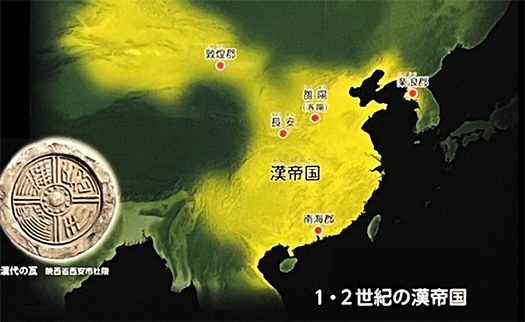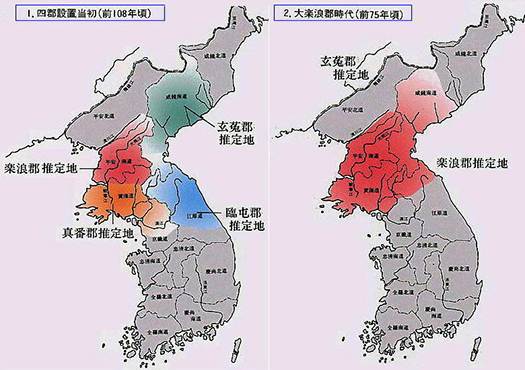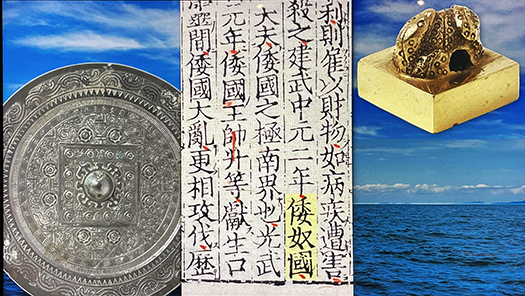


さていよいよ日本列島に国家というものが生成される歴史過程になる。
邪馬台国論争とか、古代史最大のナゾという領域なので
国立歴史民俗博物館展示でも総じて抑制的でしたが、しかし、
その後の社会変化にとって決定的でもある。避けて通るわけにも行きません。
観察者としての個人的見解ということでご理解いただければ幸い。
できるだけ客観的な事象に絞って稿を進めてみたい。
中国では秦の成立以降、中央集権的な「中華皇帝」国家が出現する。
それ以前の書物でもいくつかの「倭国」に触れた記述があるとされるけれど、
いわゆる「正史」で記述されるのは、漢の時代になる。
中国では王朝の交代ごとに前代の正史が書かれる。
前漢(紀元前206年-8年)と後漢(25年-220年)が「漢王朝」の時代。
初出は「漢書地理志」で成立は紀元後84年とされる。
班固という人物が書き前漢時代から後漢の初期のことを述べている。
1.東の海に倭人の住む島がある。倭人の国は百ケ国以上に分かれている。
2.定期的に漢に倭の国々の王の使いがやって来て、貢ぎ物を持ってくる。
もうひとつが「後漢書東夷伝」で成立は紀元後432年。
范曄という人物記述のこの後漢の歴史書では以下の通りの記載。
1.西暦57年に倭の奴国王が貢物。日本は小国分立中。奴国は日本の最南端と。
後漢の皇帝である光武帝は金印を与えた。奴国王であることを認証。
2.永初元年(107年)倭国王帥升等、生口160人を献じ、請見を願う。
成立年代に即して整理するとこういう記録があることになる。
この時代、漢は朝鮮半島いまの平壌周辺に「楽浪郡」を置いた。
巨大集権国家が日本列島の近くに権力拠点を作ったことが、
半島地域を介して日本列島社会にも激震をもたらせたと想像できる。
すでに弥生の水田農耕社会が広がっていた列島社会、
日常的な戦争行為が繰り返されていた「倭国乱れる」状況の中で
それぞれの族長層にとって、この巨大武権国家の成立、
その地方政庁・郡がすぐ近隣に出現したことが、
どれほどの外交的緊張事態であったか、火を見るよりもあきらか。
その状況の中で自分の利益追求を図るのが自然。
結果、周囲のクニに対してこの状況を利用して優越性を持とうとも考える。
たぶん、楽浪郡の以東地域、朝鮮半島社会では激震となり日本列島社会でも
このような動揺は普遍的に起こった。
なんといっても最先端文明利器としての鉄を独占的に管理している強国。

経済的にも軍事的にもその関係が地域での力関係に影響を持ったことは自明。
朝貢関係というアジア世界で一般的な国家生成過程が始まった。
このことが、日本列島の祭政にとってかなり決定的な要因になっていく。
朝貢体制に翼賛する方向もあり、一方で地域社会の求心性が高まりもする。
ただし、朝鮮半島社会も基本的にはそうであったように、
日本社会は後者の方向に向かっていったと言えるのでしょう。
中国国家に対しては独立性の高い民族自決の方向を基本的に選択した。
この楽浪郡との関係が動機として強かったように思える。
English version⬇
International Relations at the Founding of the Japanese Nation: The 37,000-Year History of the Japanese Archipelago – 38
The emergence of the Han Dynasty’s ruling body called Yeoknam-gun in the northern part of the Korean Peninsula caused an upheaval in the society of the peninsula. The Kuni society of the Japanese archipelago is also hit by the upheaval.
Now comes the historical process of the creation of a nation in the Japanese archipelago.
Since this is an area of the greatest riddle in ancient history, such as the “Yabataikoku” controversy, the National Museum of Japanese History exhibition was generally restrained.
The National Museum of Japanese History exhibition was generally restrained, but it is, however, also decisive for the social changes that have taken place since then.
However, it is also decisive for the social changes that have occurred since then. We cannot avoid it.
I hope you will understand that this is my personal view as an observer.
I would like to focus on objective events as much as possible.
After the establishment of the Qin Dynasty, a centralized “Chinese emperor” state emerged in China.
Although there are some descriptions of “Yamato” in books written before the establishment of the Qin Dynasty, there are no descriptions in the so-called “authentic history” of Japan.
However, it was not until the Han dynasty that the so-called “authentic history” of Japan was written.
In China, an official history of the previous dynasty is written for each dynastic change.
The Former Han Dynasty (206-8 B.C.) and the Later Han Dynasty (25-220 B.C.) were the periods of the “Han Dynasty.
The first edition of the “Han Book of Geography” is said to have been written in 84 A.D.
It was written by a man named Hanguo, and describes the period from the Former Han Dynasty to the early years of the Later Han Dynasty.
There is an island in the eastern sea where the Japanese live. The Japanese nation is divided into more than a hundred countries.
2. Periodically, envoys of the kings of the Japanese nations would come to Han to bring tribute.
The other is the “Later Han Book of Oriental and Barbarian Biography,” which was established in 432 AD.
In this history book of the Later Han Dynasty, written by a man named Fan Ye, the following is described.
In 57 A.D., King Nukoku of Japan paid tribute. Japan was in the process of dividing into smaller countries. Nukoku is the southernmost part of Japan.
Emperor Kwangmu, the emperor of the Later Han Dynasty, gave a gold seal Authenticating that he was the King of Nukuni.
In the first year of Eishu (107th year), the king of Nukoku, Marshal Masu, presented 160 people and asked for their cooperation.
The records of this period are as follows.
In this period, the Han Dynasty established “Yeoknam-gun” in the vicinity of what is now Pyongyang on the Korean peninsula.
The fact that a large centralized state established a base of power near the Japanese archipelago is a clear indication that the Han Dynasty had a strong influence on Japanese society through the peninsula region.
The establishment of a power base near the Japanese archipelago by a large centralized state can be imagined to have sent tremors through the peninsula to the society of the Japanese archipelago.
The Yayoi paddy-field farming society had already spread across the archipelago.
In the midst of the “Japanese Warring States” situation, in which daily acts of war were being repeated, it is not difficult to imagine the impact of this huge earthquake on the local society.
The establishment of this huge military power state, and its local government offices and counties
The fact that the local government offices and counties of the state appeared in the immediate vicinity was a source of great diplomatic tension.
It is obvious how much diplomatic tension there was for each of the chiefs.
Under such circumstances, it was natural for them to pursue their own interests.
As a result, they also wanted to take advantage of the situation to gain superiority over the surrounding kunis.
Perhaps, such an upheaval, which has become a major shock in the Korean Peninsula and society east of Yerelam-gun, will also be felt in the Japanese archipelago.
Such upheavals occurred universally in the Japanese archipelago.
After all, this is a powerful country that exclusively controls iron as the most advanced civilized weapon.
It is obvious that the relationship had an impact on power relations in the region, both economically and militarily.
The tribute relationship, a state-generating process common in the Asian world, began.
This would become a fairly decisive factor for the ritual government of the Japanese archipelago.
There was a winging of the tribute system, and on the other hand, the centripetal force of the local community increased.
However, as was basically the case with Korean society
Japanese society could be said to have moved in the latter direction.
It basically chose the direction of national self-determination with a high degree of independence vis-à-vis the Chinese nation.
This relationship with Rakunami-gun seems to have been a strong motive.
Posted on 12月 8th, 2022 by 三木 奎吾
Filed under: 日本社会・文化研究, 歴史探訪







コメントを投稿
「※誹謗中傷や、悪意のある書き込み、営利目的などのコメントを防ぐために、投稿された全てのコメントは一時的に保留されますのでご了承ください。」
You must be logged in to post a comment.